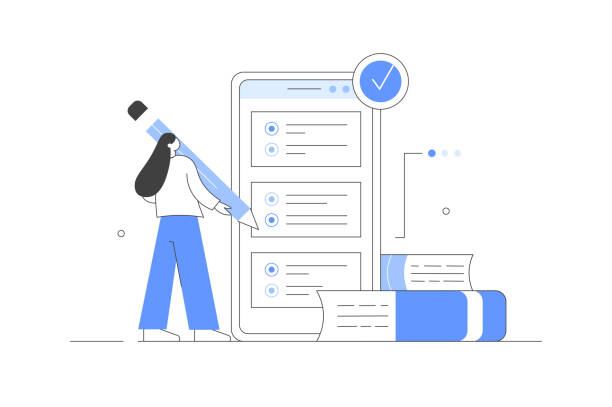Introduction to the Importance of Secure Website Design in the Digital World

In the current era, where daily life and businesses are strongly intertwined with the online space, #secure website design has become more vital than ever.
An #insecure website can not only damage your business’s #reputation but may also lead to the loss of sensitive user data, financial damages, and even legal prosecution.
#Website security is a comprehensive concept that includes data protection, prevention of unauthorized access, countering cyber attacks, and maintaining system integrity.
Investing in secure website design is, in fact, an investment in user trust and the long-term stability of your business.
This explanatory section helps you gain a better understanding of why this topic is important in today’s digital world and how a strong security strategy can protect you against increasing threats.
Without attention to security, any effort to grow online may ultimately remain fruitless.
Tired of losing customers due to poor e-commerce website design? With Rasawwb, solve this problem forever!
✅ Increase sales and visitor-to-customer conversion rates
✅ Smooth and engaging user experience for your customers⚡ Get free consultation
Common Web Security Threats and How to Identify Them

To achieve secure website design, we must first become familiar with the common threats targeting websites.
These threats can range from simple attacks to complex and organized ones.
Among the most common attacks are SQL Injection, aimed at unauthorized database access, Cross-Site Scripting (XSS) for injecting malicious code into web pages, and DDoS attacks to take a site offline.
Also, phishing attacks and the use of malware are serious risks.
Identifying these threats requires specialized knowledge and the use of appropriate tools.
Regular penetration testing, vulnerability scanners, and periodic review of server logs are among the effective methods for identifying weaknesses and preventing attacks.
This analytical and specialized approach helps you identify potential weaknesses in your website security with a broader perspective and take necessary measures before an incident occurs.
Fundamental Principles of Secure Website Design: Implementing SSL/TLS Certificates

One of the most important fundamental principles in secure website design is the use of SSL/TLS certificates.
These certificates are responsible for encrypting information exchanged between the user and the server and prevent eavesdropping, tampering, or forging of data.
The presence of a green padlock icon in the browser’s address bar and the HTTPS prefix indicates site security and trustworthiness for users.
Not using SSL not only harms your website’s security but can also negatively impact your SEO ranking, as search engines prioritize HTTPS sites.
The choice of certificate type (DV, OV, EV) depends on the needs and level of trust required for your website.
Proper implementation of SSL/TLS is a fundamental step in ensuring web security and protecting user privacy.
In addition to SSL, using secure coding, validating user inputs, and filtering outputs are also core components in this journey.
This guiding and specialized section helps you create a robust defense layer for your website.
Table 1: Types of SSL/TLS Certificates and Their Applications
| Certificate Type | Description | Suitable for |
|---|---|---|
| Domain Validation (DV) | Domain ownership validation. Simplest and fastest type. |
Blogs, personal websites, small websites. |
| Organization Validation (OV) | Domain ownership and organizational information validation. | Medium businesses, e-commerce sites. |
| Extended Validation (EV) | Strictest organizational identity validation, green address bar. | Banks, financial institutions, large corporations. |
| Wildcard SSL | Encrypts the main domain and all its subdomains. | Sites with multiple subdomains (e.g., blog.example.com, shop.example.com). |
The Role of Firewalls and Intrusion Detection Systems in Enhancing Web Security

Another key component in secure website design is the use of defensive tools such as Web Application Firewalls (WAF) and Intrusion Detection Systems (IDS) or Intrusion Prevention Systems (IPS).
A WAF acts as a barrier between your website and the internet, monitoring incoming and outgoing traffic to identify and block malicious requests, including SQL Injection, XSS, and DDoS attacks.
These firewalls can detect unusual traffic patterns based on a set of predefined rules or by using artificial intelligence and machine learning.
Alongside WAF, IDS/IPS systems continuously monitor the network and system, identifying intrusion attempts or suspicious activities and blocking them if necessary.
Implementing these defensive layers is crucial, especially for websites that process sensitive data. These tools significantly contribute to site stability and optimal performance by providing a more secure environment.
This analytical section demonstrates how combining these technologies can significantly enhance overall website security.
Does your company’s website perform as befits your brand? In today’s competitive world, your website is your most important online tool. Rasawwb, specializing in professional corporate website design, helps you to:
✅ Gain customer credibility and trust
✅ Convert website visitors into customers
⚡ Get a free consultation!
Password Management and Two-Factor Authentication: A Powerful Defense Layer

The role of users and how their credentials are managed in website security is undeniable.
Weak and easily guessable passwords are one of the biggest vulnerabilities in any system.
To ensure secure website design, users should be encouraged to use complex and unique passwords, and mandatory policies should be put in place for this purpose.
These policies include minimum password length, a combination of uppercase and lowercase letters, numbers, and special characters, and prohibition of common passwords.
Furthermore, implementing Two-Factor Authentication (2FA) is considered a very strong defense layer.
By enabling 2FA, even if a user’s password is compromised, an attacker will not be able to log in without access to the second factor (such as a code sent to a mobile phone or an authenticator app).
This educational and guiding section emphasizes that security is not limited to coding; rather, user education and empowerment are integral parts of a successful security strategy.
Continuous Updates and Security Monitoring: An Ever-Present Necessity

Even the best secure website design will become vulnerable without continuous maintenance and updates.
Security threats are constantly evolving, and new vulnerabilities are regularly discovered.
Therefore, it is essential that all website components, including the Content Management System (CMS), plugins, themes, and server, are always updated to their latest secure versions. These updates often include security patches to address known weaknesses.
In addition to updates, continuous security monitoring is also of high importance.
This monitoring includes reviewing server logs, observing network traffic to identify suspicious activities, and using monitoring tools to detect unauthorized changes in files or settings.
This informative and analytical approach highlights the importance of vigilance and rapid response to threats.
Follow security news and alerts and always be ready to take necessary actions to maintain your website’s security if needed.
Regular Backup and Disaster Recovery Plan: A Vital Strategy

One of the most important aspects of maintaining website security and stability is planning for worst-case scenarios.
Even with the best security measures, your website may suffer an attack or disruption.
In such circumstances, having a regular backup plan and a well-defined Disaster Recovery Plan is crucial.
Backups should include all website files, databases, and server configurations.
These backup copies should be stored in secure and preferably separate locations (off the main server).
Periodic testing of the data recovery process is of high importance to ensure that in times of crisis, you can quickly restore your website without data loss.
This specialized section emphasizes the importance of preparedness and having a robust backup plan for every secure website design, as quick recovery capability after an incident minimizes downtime and prevents financial and reputational losses.
Table 2: Types of Website Backup Strategies
| Backup Type | Advantages | Disadvantages |
|---|---|---|
| Full Backup | Easy and quick recovery, includes all data. | Requires large storage space, time-consuming. |
| Incremental Backup | Only changes since the last backup (full or incremental) are stored. | More complex recovery, requires the last full backup and all incremental backups. |
| Differential Backup | Only changes since the last full backup are stored. | Requires the last full backup and only the last differential backup for recovery. |
| Cloud Backup | Easy access from anywhere, high security with reputable services. | Dependence on internet connection, monthly/annual cost. |
User Education and Cybersecurity Awareness: A Long-Term Investment

Even the strongest security systems are vulnerable to human error.
Therefore, educating users and employees on cybersecurity principles is a vital step towards a secure and comprehensive website design. Many successful attacks begin through social engineering or phishing, which aim to deceive individuals into revealing sensitive information.
Conducting workshops, providing clear and transparent guidelines, and holding periodic tests to assess awareness levels can help raise users’ knowledge and vigilance.
Creating a strong security culture within the organization, where each individual understands their responsibility for security and adheres to best security practices, will significantly impact risk reduction.
This engaging (using real-world examples) and educational approach shows that web security is not just a technical responsibility, but a collective effort requiring participation and collective awareness.
Ultimately, humans are the first and last line of defense against many cyber threats.
Did you know that poor online store design can drive away up to 70% of your potential customers? Rasawwb transforms your sales with professional and user-friendly e-commerce website design.
✅ Significant increase in sales and revenue
✅ Full optimization for search engines and mobile
⚡ [Get a free consultation from Rasawwb]
The Future of Secure Website Design and Emerging Challenges

The digital world is rapidly evolving, and with the emergence of new technologies, security challenges are also becoming more complex.
The future of secure website design will increasingly be intertwined with concepts such as Artificial Intelligence (AI), Machine Learning (ML), and Blockchain.
On one hand, these technologies can provide powerful tools for detecting and countering cyber threats, but on the other hand, they themselves can become targets of new attacks.
New challenges such as Internet of Things (IoT) security, cloud security, and AI-based attacks require novel approaches and proactive thinking.
The question is whether current security systems will be able to cope with future threats? This thought-provoking and analytical section examines these challenges and emphasizes the importance of continuous research and development in cybersecurity to build websites that remain secure and stable not only today but also in the future.
Summary of Key Points for Achieving Sustainable Secure Website Design

Throughout this article, we discussed various aspects of secure website design, covering everything from the importance of SSL certificates to the role of firewalls, password management, continuous updates, backup planning, and user education.
Ensuring website security is not a one-time process but requires continuous commitment and a multi-layered approach. Each of the mentioned actions can be effective on its own, but their combination creates a comprehensive and powerful defense against cyber threats.
To achieve a sustainable secure website design, you must always be vigilant, stay informed about the latest security technologies, and train your team.
Remember that website security not only protects your and your users’ information but also significantly contributes to the long-term credibility and success of your online business.
This explanatory section provides a summary and conclusion of the key points discussed in the article.
Frequently Asked Questions
| No. | Question | Answer |
|---|---|---|
| 1 | What does secure website design mean? | Secure website design refers to a set of measures and methods used to protect a website against cyber attacks, unauthorized access, data breaches, and other security threats. Its goal is to maintain the confidentiality, integrity, and availability of information. |
| 2 | Why is website security important? | Website security is critically important for maintaining user trust, protecting sensitive information (such as personal and financial data), preventing financial losses, preserving brand reputation, and complying with legal regulations (such as GDPR). A security breach can lead to customer loss and heavy penalties. |
| 3 | What are some of the most common security attacks against websites? | Common attacks include SQL Injection, XSS (Cross-Site Scripting), CSRF (Cross-Site Request Forgery), Brute Force, DDoS attacks, Broken Authentication, and Missing Function Level Access Control. |
| 4 | What is the role of SSL/TLS certificates in website security? | SSL/TLS certificates (which lead to an HTTPS address) are used to encrypt data exchanged between the user and the website server. This prevents eavesdropping or tampering with sensitive information such as passwords and credit card details during transmission and verifies the website’s authenticity. |
| 5 | How can SQL Injection attacks be prevented? | To prevent SQL Injection, Prepared Statements or ORM (Object-Relational Mapping) with parameterized queries should be used. Additionally, thorough filtering and validation of user inputs (Input Validation) and applying the principle of least privilege in the database are essential. |
| 6 | What is HTTP Strict Transport Security (HSTS) and how does it help security? | HSTS is a web security policy that tells browsers to load the website only via an HTTPS connection, even if the user enters the address with HTTP. This prevents downgrade attacks and cookie hijacking on public Wi-Fi networks. |
| 7 | What is the importance of regular software and plugin updates in website security? | Regular updates of Content Management Systems (CMS), plugins, themes, and other software components of a site are crucial for addressing discovered security vulnerabilities. Developers continuously release security patches, and failing to update can leave a site vulnerable to known attacks. |
| 8 | What measures can be taken to increase the security of the website administration section (admin panel)? | Changing the default admin panel path, using strong passwords and two-factor authentication (2FA), restricting access to specific IPs, using CAPTCHA on login pages, monitoring logs, and continuous CMS updates are among these measures. |
| 9 | Why is filtering and validating user inputs (Input Validation) important? | Input filtering and validation help prevent the injection of malicious code or unauthorized data through forms, URLs, or other user input sections. This prevents attacks like XSS and SQL Injection that exploit invalid inputs. |
| 10 | Name some common tools or services for checking and enhancing website security. | Tools like Web Application Firewalls (WAF), vulnerability scanners (e.g., Acunetix, Nessus), Intrusion Detection and Prevention Systems (IDS/IPS), CDN services with security features (e.g., Cloudflare), and periodic Penetration Testing can enhance website security. |
And other advertising services of Rasawwb Advertising Agency
Smart Google Ads: A professional solution for improving SEO ranking with a focus on optimizing key pages.
Smart Digital Advertising: An innovative platform for improving website traffic increase with intelligent data analysis.
Smart SEO: A dedicated service for growth in SEO ranking improvement based on intelligent data analysis.
Smart Website Development: A new service for increasing campaign management through user experience customization.
Smart Brand Identity: Designed for businesses seeking digital branding through the use of real data.
And over a hundred other services in the field of internet advertising, advertising consultation, and organizational solutions
Internet Advertising | Advertising Strategy | Advertorial
Sources
Website Security and Its ChallengesSustainable Website Design: Principles and FoundationsProtecting User Information on Websites10 Ways to Increase Website Security
? Are you looking for a major leap in the digital world? “Rasawwb Afarin” Digital Marketing Agency, specializing in Search Engine Optimization (SEO), professional social media management, and user-friendly website design, guides your business towards success. With us, establish a powerful and lasting online presence.
📍 Tehran, Mirdamad Street, next to Bank Markazi, Southern Kazeroon Alley, Ramin Alley, No. 6



